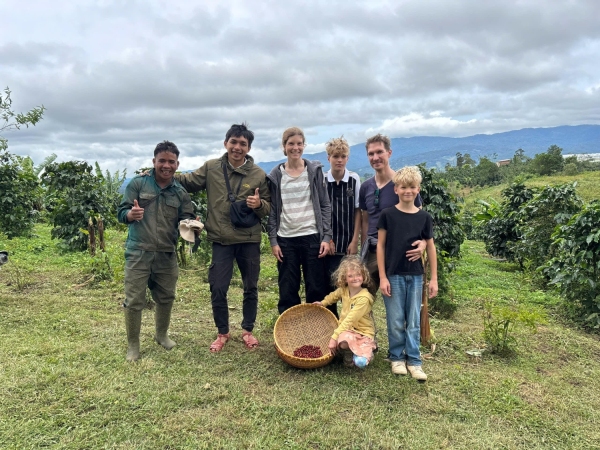
Most people assume coffee cherries ripen all at once, but in reality, coffee trees produce fruit in different stages, making selective harvesting incredibly challenging. Farmers must return multiple times to ensure only ripe cherries are picked, but this process is labor-intensive and costly.

💡 Why HuyEco Insists on 100% Ripe Cherry Harvesting:
✅ Enhances flavor development – Eliminates harsh bitterness and grassy aftertaste from unripe beans.
✅ Improves coffee consistency – Ensuring all beans roast evenly without defects.
✅ Supports fair pricing – Specialty-grade coffee demands higher prices, benefiting farmers in the long run.
Despite these benefits, many producers prioritize quantity over quality, harvesting coffee indiscriminately—leading to serious consequences for both consumers and Vietnam’s reputation in coffee exports.
Harvesting Robusta coffee with smallholder farmers – showcasing the effort behind selective picking for better quality.
In Vietnam, especially around Đà Lạt during harvest season, it's common to see strip-harvested coffee drying along national roads. While this method is convenient, it comes with two major issues:

❌ Mixed ripeness leads to defects – Bitter flavors from unripe beans and excessive fermentation from overripe ones.
❌ Humidity & mold risk – The Central Highlands climate is rainy, and drying coffee on the ground increases mold contamination risks, leading to toxins like Ochratoxin, which can be harmful to health.

Mass-harvested coffee often ends up in low-quality blends or instant coffee, sold cheaply without consumers realizing its defects. Without proper education, the market continues to favor quantity over quality, harming the industry in the long term.
🚜 Selective Picking, Not Mass Harvesting – Only ripe cherries are chosen, ensuring flavor consistency.
☀ Controlled Drying Process – Coffee is dried in clean, ventilated spaces, avoiding ground contamination.
🔥 Test Roasting for Defect Detection – At 80-150°C, mold is immediately identified, preventing bad batches from reaching consumers.
📊 Color Consistency Across All Roast Levels – HuyEco coffee remains visually uniform, unlike poorly sorted beans that show uneven roasting.

To truly assess green coffee quality, we must apply a systematic approach:
✅ Smell Inspection – Any off-putting odor signals moisture damage or excessive fermentation, which can negatively impact taste and safety.
✅ Color Evaluation – Consistent gold-green hues indicate ripe cherry selection, while mixed shades suggest low harvest standards.
✅ Physical Defect Check – Identifying beans that are insect-damaged, over-fermented, cracked, or contaminated is crucial for maintaining clean coffee profiles.
✅ Trusted Suppliers – The most vital factor is choosing an experienced supplier who prioritizes ripe cherry selection, proper drying methods, and ethical sourcing.
At HuyEco Coffee, we uphold these standards to ensure Vietnamese coffee evolves sustainably, moving away from mass-production defects toward high-quality, ethically sourced beans.



✨ Better coffee begins with better choices – Join HuyEco’s journey toward sustainability.
To improve Vietnam’s coffee reputation, education is key:
📢 Consumers must learn the difference between quality coffee and mass-market blends.
☕ Choosing ethical coffee brands encourages better farming practices.
🚜 Supporting sustainable farms ensures higher standards for coffee production.
📌 Experience HuyEco’s commitment to sustainability:
🔗 Order sustainably sourced coffee beans: https://huyeco.vn/en/page/order-coffee.html
🔗 Join a farm tour & witness quality control firsthand: https://huyeco.vn/en/page/eco-coffee-tour.html
🔗 Visit HuyEco Café & taste defect-free coffee: https://huyeco.vn/en/page/huyeco-coffee-shop.html
Vietnam’s coffee industry has immense potential, but ensuring long-term success requires prioritizing quality over mass production. At HuyEco, we’re dedicated to clean coffee, ethical sourcing, and consumer education to help shape the future of Vietnamese coffee.
✨ HuyEco – A Coffee Revolution for Sustainability. Join Us Today.
👉 Order HuyEco Specialty Coffee
Hand-picked Arabica & Robusta, carefully processed and delivered farm-to-cup.
👉 Book a Coffee Farm Tour
See firsthand how we sort defects, dry coffee properly, and ensure quality.
👉 Visit HuyEco Café in Da Lat
Taste clean, defect-free coffee in a local, sustainable setting.
👉 Arabica Coffee in Vietnam – Sustainable Farming & Processing
Explore ripe cherry selection, fermentation, and organic cultivation.
👉 Sustainable Robusta – From Farm to Cup
Learn how HuyEco elevates Robusta through defect control and biodiversity.
👉 Liberica – Mit Coffee for a Sustainable Future
Discover the potential of Liberica when processed with care.
👉 Specialty Coffee Association – Green Coffee Defect Standards
Guidelines for identifying and removing defects in green coffee beans.
👉 World Coffee Research – Coffee & Climate Change
Research on how processing and drying affect bean quality and safety.
👉 Rainforest Alliance – Sustainable Coffee Certifications
Standards for traceability, clean processing, and ethical sourcing.
👉 Vietnam Coffee & Cocoa Association (VICOFA)
Market insights and quality trends in Vietnam’s coffee industry.
Reader Comments
Newer articles
 Sustainable Coffee & Local Culture Tour in Da Lat — Arabica, Robusta & Ethical Farming
Sustainable Coffee & Local Culture Tour in Da Lat — Arabica, Robusta & Ethical Farming
 Discover Sustainable Coffee in Da Lat — A Farm-to-Cup Journey with HuyEco
Discover Sustainable Coffee in Da Lat — A Farm-to-Cup Journey with HuyEco
 Sustainable Coffee and Local Farming Realities in Da Lat HuyEc
Sustainable Coffee and Local Farming Realities in Da Lat HuyEc
 From Forest to Cup: A Personal Journey into Sustainable Coffee in Da Lat
From Forest to Cup: A Personal Journey into Sustainable Coffee in Da Lat
 Inside HuyEco: How a Coffee Huller Machine Transformed Our Coffee Production
Inside HuyEco: How a Coffee Huller Machine Transformed Our Coffee Production
 From Forest to Cup: A Farmer’s Vision for Sustainable Coffee and Local Travel in Da Lat
From Forest to Cup: A Farmer’s Vision for Sustainable Coffee and Local Travel in Da Lat
 Field Notes from Xã Lát: Rooted in Regenerative Coffee & Indigenous Farming
Field Notes from Xã Lát: Rooted in Regenerative Coffee & Indigenous Farming
 Đưng K'Nớ: Brewing Sustainable Coffee in Vietnam’s Highland Forest
Đưng K'Nớ: Brewing Sustainable Coffee in Vietnam’s Highland Forest
 Living Coffee Ecosystem in Da Lat – HuyEco’s Way of Growing
Living Coffee Ecosystem in Da Lat – HuyEco’s Way of Growing
 Nel Drip & Wabi-Sabi: Japanese Coffee Rituals at HuyEco Da Lat
Nel Drip & Wabi-Sabi: Japanese Coffee Rituals at HuyEco Da Lat